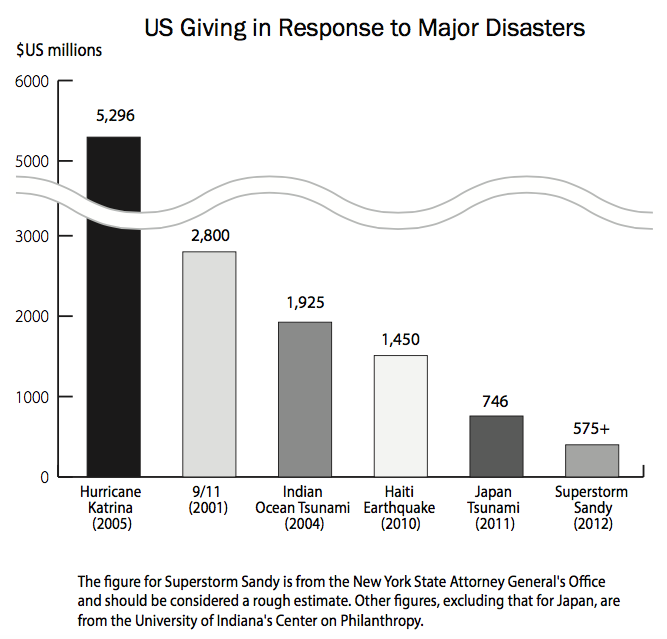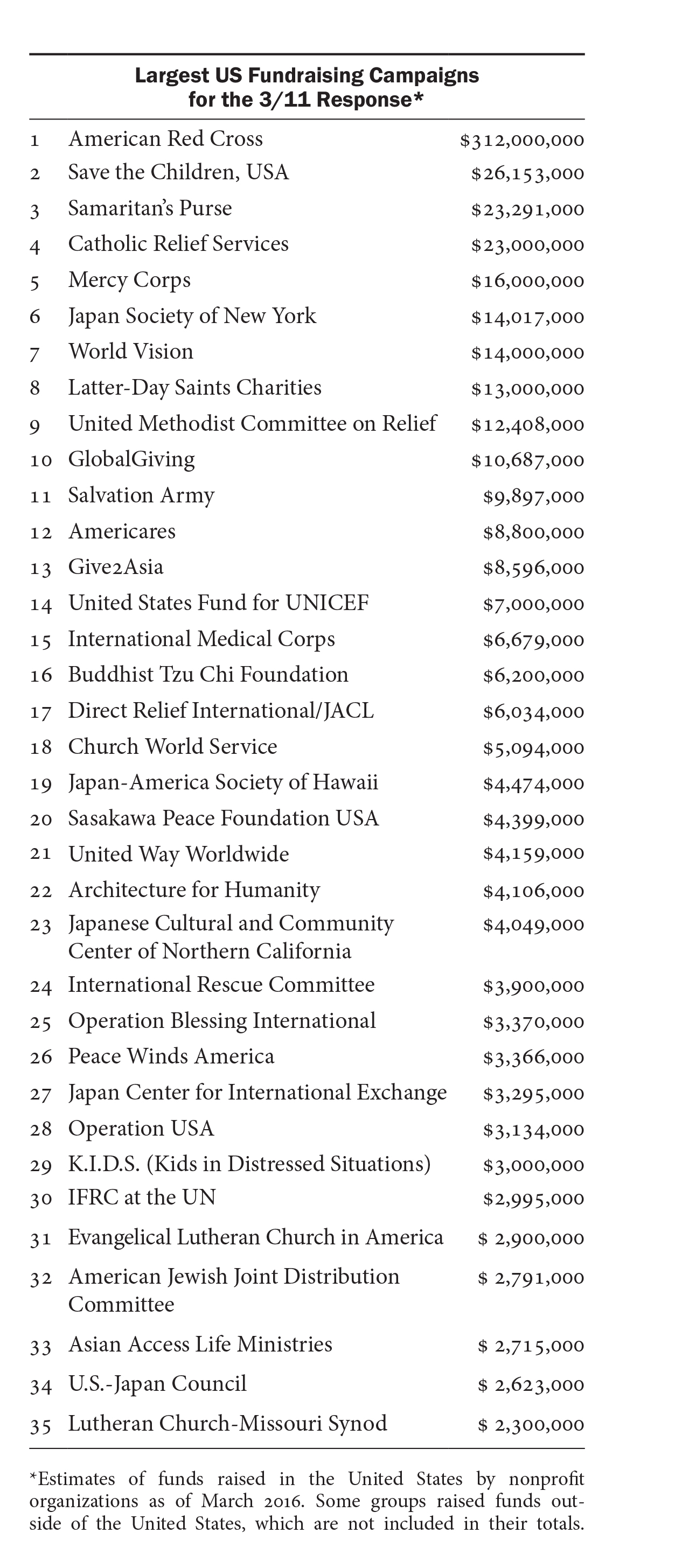March 2016
In the five years since Japan’s massive 2011 earthquake and tsunami, Americans have donated at least $746.1 million for the disaster response. This figure comes from the fifth annual JCIE survey of more than 1,300 nonprofit organizations, businesses, and fundraising campaigns. The philanthropic response to “3/11” stands out as one of the greatest outpourings of private American giving for any disaster—domestic or overseas—and the largest charitable response in US history to a disaster in another developed country.
Characteristics of the US Philanthropic Response

The magnitude of the response is of historic proportions
The total amount of American donations ranks as the fifth most generous example of disaster giving in US history, coming only after responses to Hurricane Katrina, the 9/11 attacks, the 2004 Indian Ocean tsunami, and the 2010 Haiti earthquake. The magnitude is particularly remarkable given the fact that the US media initially reported that Americans were not opening their wallets for Japan, leading with headlines such as “Americans Less Generous in Japan Disaster Relief” and “Donations to Japan Start at Slow Pace.”
In fact, the media initially underestimated the scope of 3/11 giving because it unfolded in a more bottom-up manner than had been seen with previous overseas tragedies. Around the United States, tens of thousands of community groups, churches, schools, and individuals launched fundraising drives, and then handed these funds off to larger groups that they felt would be better equipped to get them to the disaster zone. In many cases, these funds then passed through a chain of organizations before eventually making it to Japan, a contrast to previous disasters when a larger proportion of funds tended to flow to a small group of well-known organizations—ones that were easier for the media to identify and track. Fortunately, because of the long, winding road that funds took to get to Japan, the vast majority of US donations ended up being used for long-term recovery initiatives, where the needs were greater than for immediate relief.
It was extraordinarily broad and diverse
 The data collected as part of this survey also show that US giving for 3/11 was surprisingly broad-based, especially when compared with the philanthropic response to other recent overseas disasters. In the end, 48 nonprofit organizations raised over $1 million each, and at least 136 collected more than $100,000. A comparison with the 2010 Haiti earthquake response is illuminating. Barely 25 percent of American donations for Haiti were channeled through groups that did not make the list of the top 10 fundraisers, but in the case of Japan, nearly 40 percent of total donations flowed through these comparatively smaller campaigns.
The data collected as part of this survey also show that US giving for 3/11 was surprisingly broad-based, especially when compared with the philanthropic response to other recent overseas disasters. In the end, 48 nonprofit organizations raised over $1 million each, and at least 136 collected more than $100,000. A comparison with the 2010 Haiti earthquake response is illuminating. Barely 25 percent of American donations for Haiti were channeled through groups that did not make the list of the top 10 fundraisers, but in the case of Japan, nearly 40 percent of total donations flowed through these comparatively smaller campaigns.
The 3/11 response was also more organic in nature than the other large-scale outpourings of US generosity for overseas disasters. After the 2004 Indian Ocean tsunami and the 2010 Haiti earthquake, there were concerted national campaigns to encourage charitable donations with the US president making an appeal for donations from a White House podium while standing alongside former presidents deputized to lead charitable efforts. However, there was no similar high-level effort for the Japan response, and instead, the early days were marked by pundits musing that it did not make sense to donate funds to help such a rich country.
One major driver of this broad-based response was the dense web of ties that have developed between American and Japanese societies in recent decades. A wide range of US businesses made large donations, some because they had branches in Japan, others because they saw Japan as a key market, and yet others that were subsidiaries of Japanese companies. Meanwhile, numerous religious groups with sister churches in Japan launched fundraising drives. Professional associations with Japanese affiliates also mobilized support. For instance, the National Education Association collected funds for the Japan Teachers Union, the American Dental Association and the American Nurses Association launched fundraising campaigns to benefit their Japanese counterparts, and the National Association of Social Workers raised money for the Japan Social Work Association.
People-to-people ties also played a critical role. Nearly 100 municipalities with sister-city exchanges with Japan operated fundraising campaigns. Meanwhile, American alumni of the Japan Exchange and Teaching (JET) Program who had taught in Japanese schools raised more than $360,000 for the disaster response through a variety of initiatives. And discussions with organizations that raised funds suggested that people’s personal connections with Japanese acquaintances or to some aspect of Japanese society or culture played an important role in fueling individual giving to other campaigns.
US-Japan organizations played an important role
Most of the organizations that responded to 3/11 were humanitarian groups that were accustomed to raising funds for disaster responses or professional philanthropic intermediaries like the United Way or GlobalGiving. However, compared with other major international disaster responses, a large number of groups that focus primarily on bilateral ties mobilized for the response. When the Haiti earthquake struck, 3 of the top 60 US donors were long-standing organizations that focused specifically on Haiti. By comparison, 15 of the 60 nonprofit organizations raising the most funds for 3/11 were organizations dedicated to some aspect of US-Japan relations.
Overall, more than 75 US-Japan groups launched their own relief funds, together collecting more than $51 million to distribute in Japan. These included Japan-America societies, US-based Japanese chambers of commerce, Japanese-American associations, and even several policy institutes that focus on US-Japan relations.
Looking Back after Five Years
The US philanthropic response seems to have had an outsized impact in at least two ways. It provided important support for Japan’s weak nonprofit sector as those organizations scrambled to help communities affected by the disaster. Japanese citizens gave more for this disaster than ever in history, but nearly 85 percent of domestic contributions were made to government agencies or the country’s traditional gienkin funds that give cash payments directly to survivors. In contrast, more than 90 percent of contributions from the United States were used for nonprofit activities, meaning that American contributions accounted for a surprisingly large portion of the funding for Japanese nonprofit groups active in the disaster zone.
The outpouring of donations also helped give birth to an extraordinary number of US-Japan exchange programs. A JCIE study found that more than 150 grassroots exchanges, many of which had the ulterior motive of helping children and other survivors deal with the psychosocial impact of the disaster, were created after the disaster, often with funds raised by US groups.
Now, at the five-year mark, it is clear that the recovery process will continue for at least another decade—nearly 65,000 survivors remain in temporary housing today, and many communities are still trying to get back on their feet. Hundreds of Japanese groups continue working to support the recovery although funding into the disaster zone has slowed dramatically. The role of US donors has, by and large, come to an end, and most American organization have wound down their fundraising efforts although a handful of US-Japan groups are still raising funds. But in retrospect, it is clear that, by fueling a historic outpouring of generosity, the strong web of ties between the Japanese and US societies has significantly contributed to the recovery process.
Previous Surveys
- US Giving for Japan’s 2011 Disaster Totals $737 Million FOUR-YEAR REPORT | MARCH 2015
- US Giving for Japan Disaster Reaches $730 Million THREE-YEAR REPORT | MARCH 2014
- US Giving in Response to Japan Disaster Exceeds $710 Million TWO-YEAR REPORT | MARCH 2013
- US Giving in Response to Japan’s March 11 Disaster Exceeds $665 Million 18-MONTH REPORT | SEPTEMBER 2012
- US Giving in Response to Japan’s March 11 Disaster Tops $630 Million ONE-YEAR REPORT | MARCH 2012
Survey Methodology
This report updates earlier JCIE surveys published annually since March 2012. JCIE staff in New York and Tokyo have gathered information from 1,318 American and Japanese organizations: 753 US nongovernmental organizations, 499 US corporations, 54 of Japan’s leading nonprofit organizations, and 12 Japanese consulates that accepted funds from American donors. Information was collected via telephone, e-mail, and online research to come up with an aggregate total for US giving in response to the 3/11 disaster.
The estimate includes corporate donations, foundation giving, and individual donations through US-based organizations. It counts funds that are disbursed or committed to Japan, and it excludes contributions from US government agencies. Since donations tend to pass through multiple organizations’ accounts while being channeled to groups working on the ground in the disaster zone, special attention was paid to minimizing the potential for double-counting of donations.
